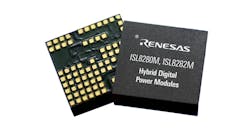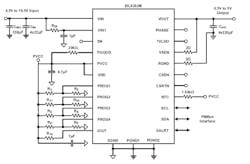Tiny Step-Down Power Modules Offer Superior Density, Transient Performance
Encapsulated power modules are shrinking to where they they could be confused with the larger ICs they support, such as FPGAs. The 10-A ISL8280M and pin-compatible 15-A ISL8282M developed by Renesas Electronics Corp. are fully encapsulated dc-dc PMBus hybrid digital power modules housed in 12- × 11-mm packages (the otherwise similar 10-A ISL8280M and 15-A ISL8282M “analog” modules don’t have the PMBus) for a power density of 115 mA/mm2 with up to 95% peak efficiency (Fig. 1). These single-channel, synchronous, step-down regulated power supplies operate over a wide input-voltage range of 5 to 16 V and deliver an output between 0.5 to 5 V.
1. The 10- and 15-A Renesas dc-dc step-down power modules are compact, fully encapsulated modules that require only input and output ceramic capacitors. (Source: Renesas Electronics Corp.)
Within each thermally optimized Grid High Density Array (GHDA) module is a PWM controller, MOSFETs, and inductor; the complete dc-dc subsystem requires addition of only input and output ceramic capacitors. The proprietary GHDA package offers superior electrical and thermal performance through a single-layer conductive package substrate. It efficiently transfers heat from the module to the system board, and dissipates it without requiring airflow or heatsinks, even under heavy load conditions. Modules also include fault protection with voltage, temperature, and current protections.
For a given module, users can select among an array of configurations and settings for frequency, VOUT, and AV gain), all achieved without the need for built-in non-volatile memory. The module “customization” is achieved via four 8-bit configuration pins, each with up/down resistors with values set according to a detailed table in the datasheet (this is an advanced form of the classic “pin-strapping” often used for configuration setup) (Fig. 2). Thus, the same stocked module unit can be used across different products or for different rails within the same design.
2. Configuration of each module is accomplished via four programming pins, each with an up/down resistor pairing. (Source: Renesas Electronics Corp.)
The ISL828xM hybrid digital and ISL821xM analog power modules include integrated LDOs for single-supply operation. All of the modules use Renesas’ patented R4 high-speed control-loop architecture with inherent line-voltage feed-forward, which provides a combination of ultra-fast load transient response; accurate, regulated frequency control (all with internal-only compensation); and high noise immunity.
Design-in support includes comprehensive datasheets with tables and graphs detailing minimum, maximum, static, and dynamic performance. In addition, the Renesas PowerCompass tool helps users quickly identify the right power modules and other parts that match their specific requirements (multiple power rails can be set up for more than 200 FPGAs). And the company’s PowerNavigator tool works with the PMBus, allowing designers to set up module telemetry, sequencing, and run-time configuration.
The four modules in the series are available now. The PMBus-compatible 10-A ISL8280M and 15-A ISL8282M cost $10.63 and $13.73, respectively, while the ISL8210M and ISL8212M non-PMBus modules are $9.41 and $12.51 (1000-piece lots).
About the Author

Bill Schweber
Contributing Editor
Bill Schweber is an electronics engineer who has written three textbooks on electronic communications systems, as well as hundreds of technical articles, opinion columns, and product features. In past roles, he worked as a technical website manager for multiple topic-specific sites for EE Times, as well as both the Executive Editor and Analog Editor at EDN.
At Analog Devices Inc., Bill was in marketing communications (public relations). As a result, he has been on both sides of the technical PR function, presenting company products, stories, and messages to the media and also as the recipient of these.
Prior to the MarCom role at Analog, Bill was associate editor of their respected technical journal and worked in their product marketing and applications engineering groups. Before those roles, he was at Instron Corp., doing hands-on analog- and power-circuit design and systems integration for materials-testing machine controls.
Bill has an MSEE (Univ. of Mass) and BSEE (Columbia Univ.), is a Registered Professional Engineer, and holds an Advanced Class amateur radio license. He has also planned, written, and presented online courses on a variety of engineering topics, including MOSFET basics, ADC selection, and driving LEDs.



